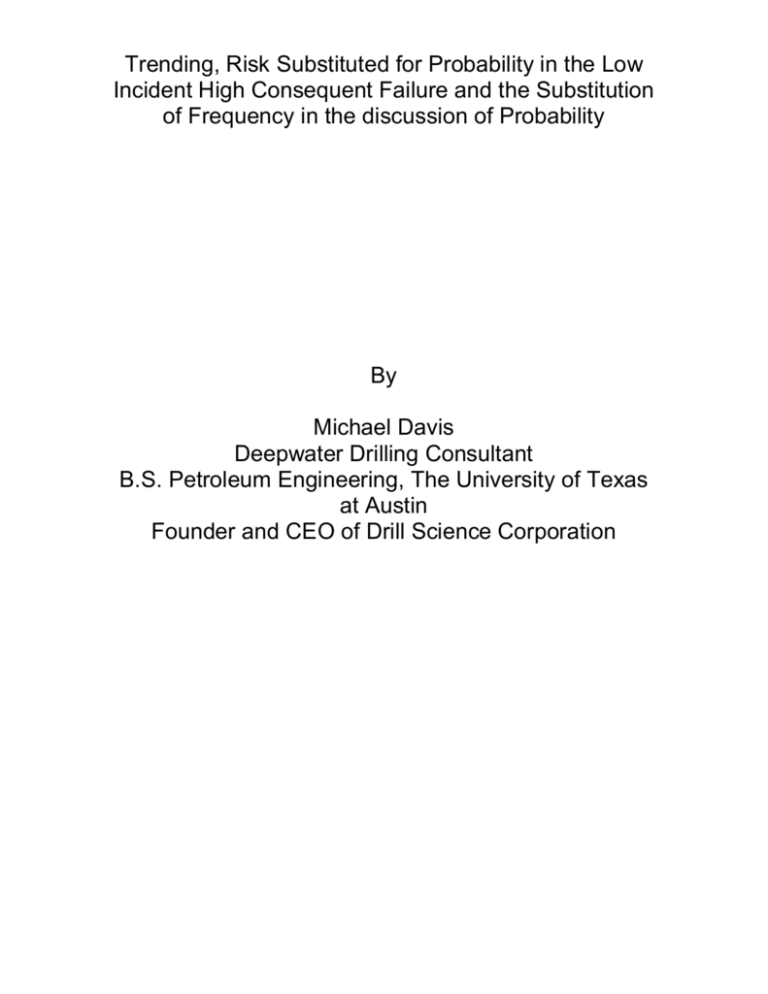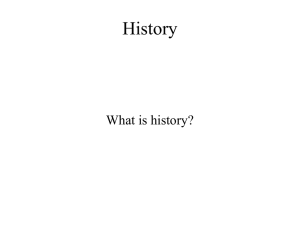Luck vs Trending Risk
advertisement

Trending, Risk Substituted for Probability in the Low Incident High Consequent Failure and the Substitution of Frequency in the discussion of Probability By Michael Davis Deepwater Drilling Consultant B.S. Petroleum Engineering, The University of Texas at Austin Founder and CEO of Drill Science Corporation Deepwater is trending towards interactive complexity and tighter coupling, not only in the physics between the wellbore and drilling equipment and team and mother nature and yet in the office in the design and execution process in general. Also, there is a trend in frequency. In the coming years there will be more deepwater drilling rigs and therefore the frequency of projects moving towards the stats in probability that must be increasing due to trending complexity and tighter coupling and the simple fact that easy prospects are drilled first. We mustn’t confuse frequency, probability, consequence, vulnerability, exposure and risk with simple luck and yet that is exactly what happens in the outcome bias. The outcome bias is an error made in evaluating the quality of a decision when the outcome of that decision is already known. Specifically, the outcome effect occurs when the same “behavior produce[s] more ethical condemnation when it happen[s] to produce bad rather than good outcome, even if the outcome is determined by chance.” This is attributing “luck” to “success” and is rampantly involved in the issue of drilling process safety. While similar to the hindsight bias, the two phenomena are markedly different. The hindsight bias focuses on memory distortion to favor the actor, while the outcome bias focuses exclusively on weighting the past outcome heavier than other pieces of information in deciding if a past decision was correct. Many organizations are judging their past decisions, their current processes and the errors of their employees “unjustly” exactly because of the prevalence of the human error of the outcome bias in drilling organizations. Author David Marx, identifies several biases that he believes can directly undermine worker safety (and public safety). Marx, in his book, Whack a Mole: The Price We Pay for Expecting Perfection Marx introduces the concept of severity bias. According to Marx, severity bias is the practice of enforcing greater consequences for those events that produce a more severe outcome. Marx argues that the outcome of at risk behavior is immaterial—that the true risk lies in the flawed decision making and recklessness. In other words, it doesn’t matter whether or not an employee’s actions have never killed or injured someone, the fact that the behavior’s rewards are so out of proportion with the potential for harm is enough to judge it inappropriate. If we buy into this bias, we tend to excuse inappropriate risk taking—and even recklessness—provided that the behaviors don’t result in an incident. Professional Bias. Marx also identifies a tendency to treat behaviors more harshly as one gets closer to the front line of operations. Research has shown that people tend to let higher ranking professionals off the hook not out of fear of retaliation, but simply because the higher the rank of a professional the more likely that people will assume that the executive knows what he or she is doing and is therefore less deserving of coaching or discipline. When you exhibit professional bias you create a multi-tiered system of accountability. Simply stated, you have a double (or triple) standard. Some Hazards Are Just Common Sense. Another great thinker on the topic of bias as it pertains to safety is Dr. Robert Long. Long explores the relationship between risk and human judgment in his book, Risk Makes Sense. Long contends that there is no such thing as common sense. According to Long intelligent people make sense of the situation based on there personal experiences, things they have been taught by their parents, teachers, and peers. To expect that a worker will intuitively assess the risk of a hazard the way others in the population would is unreasonable. But often we take it for granted that people will understand the intrinsic dangers of a circumstance and fail to manage the hazard as being too trivial, condescending, or even insulting were we to mention it.





